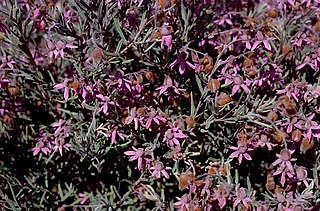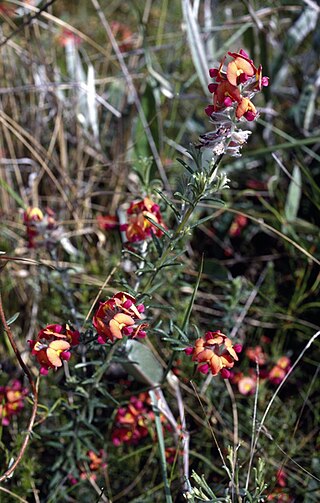
Thomasia sarotes is a species of flowering plant in the family Malvaceae. It is an upright, spreading shrub with purple, pink to mauve or white flowers and is endemic to the south-west of Western Australia.

Thomasia pygmaea, commonly known as tiny thomasia, is a species of flowering plant in the family Malvaceae and is endemic to southern Western Australia. It is a low, dense, compact shrub with broadly heart-shaped to egg-shaped or more or less round leaves and pink to purple flowers.

Bossiaea spinosa is a species of flowering plant in the family Fabaceae and is endemic to the south-west of Western Australia. It is a low, dense prostrate or rounded, twiggy shrub with egg-shaped to elliptic leaves and deep yellow to orange and pinkish-red, pea-like flowers.
Dillwynia divaricata is a species of flowering plant in the family Fabaceae and is endemic to the south-west of Western Australia. It is an erect, spindly shrub with cylindrical, grooved leaves and yellow flowers with brownish markings.
Hibbertia helianthemoides is a species of flowering plant in the family Dilleniaceae and is endemic to a small area in the south-west of Western Australia. It is a prostrate to low-lying, spreading to erect, hairy shrub with hairy foliage, linear leaves and yellow flowers with thirteen stamens.
Pultenaea purpurea is a species of flowering plant in the family Fabaceae and is endemic to the south of Western Australia. It is a small prostrate shrub with cylindrical leaves and yellow-orange and red flowers.

Daviesia lancifolia is a species of flowering plant in the family Fabaceae and is endemic to the south-west of Western Australia. It is a prostrate to erect, spreading shrub with egg-shaped, more or less round or linear phyllodes and yellow to orange and red flowers.

Lasiopetalum quinquenervium is a species of flowering plant in the family Malvaceae and is endemic to the south of Western Australia. It is an erect, spreading shrub with hairy stems and leaves, egg-shaped leaves and pink or white flowers.

Lasiopetalum rosmarinifolium is a species of flowering plant in the family Malvaceae and is endemic to the south-west of Western Australia. It is an erect or spreading shrub with hairy stems and leaves, linear leaves and white flowers.
Olearia imbricata, commonly known as imbricate daisy bush, is a species of flowering plant in the family Asteraceae and is endemic to the south-west of Western Australia. It is a shrub with small, overlapping linear leaves and bluish-purple or white, daisy-like inflorescences.

Spyridium cordatum is a species of flowering plant in the family Rhamnaceae and is endemic to the south-west of Western Australia. It is a prostrate, straggling or ascending shrub with leathery, broadly heart-shaped leaves with a notched tip, 2–4 mm (0.079–0.157 in) long with woolly, white or rust-coloured hairs on the lower side. The heads of flowers are 6.5–8.5 mm (0.26–0.33 in) wide with two to four floral leaves at the base. The sepals are up to 1.6 mm (0.063 in) long the petal tube shaggy-hairy with more or less glabrous lobes.

Mirbelia subcordata is a species of flowering plant in the family Fabaceae and is endemic to the south-west of Western Australia. It is an erect, spreading shrub with egg-shaped to lance-shaped leaves and yellow or orange and red flowers.

Thomasia rugosa, commonly known as wrinkled leaf thomasia, is a species of flowering plant in the family Malvaceae and is endemic to the south-west of Western Australia. It has wrinkled, lance-shaped to egg-shaped leaves with wavy edges, and pink to mauve flowers.
Androcalva cuneata is a species of flowering plant in the family Malvaceae and is endemic to the south-west of Western Australia. It is a low, spreading, densely hairy shrub that sometimes forms suckers and has wedge-shaped leaves and clusters of 5 to 15 pink flowers.
Commersonia rotundifolia, commonly known as round-leaved rulingia, is a species of flowering plant in the family Malvaceae and endemic to the south-west of Western Australia. It is an upright, openly-branched shrub with elliptic to round leaves with wavy edges, and white flowers in clusters of 3 to 10.

Androcalva crispa, commonly known as crisped leaf commersonia, is a species of flowering plant in the family Malvaceae and is endemic to the south-west of Western Australia. It is a prostrate shrub that forms suckers from rhizomes and has densely new growth, clusters of lobed, egg-shaped or oblong leaves with wavy, serrated edges, and groups of white and pinkish-purple flowers.

Guichenotia angustifolia is a species of flowering plant in the family Malvaceae and is endemic to the south-west of Western Australia. It is an erect, prostrate or climbing shrub with hairy young growth, hairy, oblong to linear leaves and pink to mauve flowers.
Marianthus granulatus is a species of flowering plant in the family Pittosporaceae and is endemic to a restricted part of the southwest of Western Australia. It is a twining shrub or climber with often clustered, egg-shaped to heart-shaped leaves and pale blue flowers with darker blue spots and yellow streaks, arranged in groups of three to five.
Marianthus microphyllus is a species of flowering plant in the family Pittosporaceae and is endemic to the south of Western Australia. It is a small, erect, spreading shrub with clustered, funnel-shaped, stem-clasping leaves and deep blue to almost purple flowers that darken as they age, arranged singly in leaf axils.

Chorizema cytisoides is a species of flowering plant in the family Fabaceae and is endemic to the southwest of Western Australia. It is an erect to low-lying or sprawling shrub with linear leaves and reddish-orange, yellow and purple flowers.













